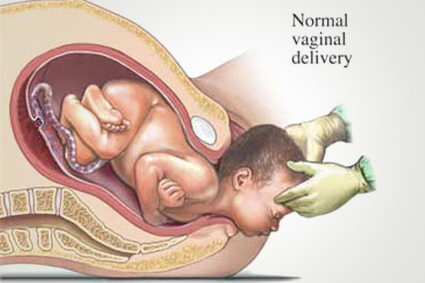Normal Vaginal Baby Delivery

Series of events that take place in different organs in an effort to expel a live baby out of uterus through the vagina into the outer world is called labour. It may occur prior to 36 weeks of pregnancy and is called preterm labour.
The labour is divided into 3 stages - first, second and third.
First Stage
It starts from the beginning of true labour pains and ends with full dilatation (opening) of cervix. The average duration is approximately 12 hours in first pregnancy and 6 hours in 2nd or more pregnancies. Initially pains are not strong and come at intervals of 15 to 30 minutes and last for 30 seconds. Gradually the interval shortens and intensity and duration increases. In late first stage the pains come at every 3-5 minutes and last for 45 seconds. Pains are usually felt shortly after uterine contraction begins and pass off before complete relaxation of uterus. Maternal and foetal condition remains unaffected except during contraction.
Management: Non interference with watchful expectancy so as to prepare the woman for a vaginal smooth delivery in 2nd stage.
- The progress of labour, maternal condition and foetal behaviour is monitored so that any deviation from the normal is detected at the earliest possible moment.
- Woman is admitted in hospital, allowed to be in a comfortable position, walk, sit or lie down, enema is given, asked to empty her bladder frequently, adequate fluid intake is adviced but should avoid solid food.
- Relief of pain- Various pain killers can be given to help the woman tolerate the pain. Epidural injection can be given if required or opted by the patient.
- Regular monitoring of blood pressure, foetal heart rate and progress of labour is done by the doctor.
Second Stage
Starts from full dilatation (opening) of cervix and ends with expulsion of the foetus. Its average duration is 2 hours in the first delivery of baby and 30 minutes in second or more deliveries. This stage concerns with coming down of foetus and delivery of the foetus through the birth canal. The intensity of pain increases. It comes at interval of 2-3 minutes and lasts for 1 - 1 1/2 minutes. It becomes successive and unbearable in terminal stage. The patient feels like pushing the baby down and out called "bearing down". The head comes out first followed by shoulders and rest of the body. Patient shows signs of exhaustion.
Management:
- Is to assist expulsion of foetus.
- To prevent injury to perineum.
- Patient is better lying down under constant supervision of the doctor.
- Nothing has to be taken by mouth except water or ice.
- Patient is shifted to the labour table and given the position for delivery.
- With help of the doctor the head of foetus slowly passes out of the vagina then the shoulder and rest of the body slips out.
- The slow process prevents injuries to the perineum of the patient.
- The umblical cord is clamped (tied) and cut.
- If the paediatrician is present, baby is handed over to him.
Third Stage
It begins after the expulsion of foetus and ends with expulsion of placenta and membranes. Its average duration is 15 minutes. The pain stops for a short time. However, intermittent discomfort in the lower abdomen re-appears, corresponding with the uterine contractions. Placenta is expelled by "bearing down" efforts or manual manipulation. Slight bleeding may be present. The patient may have chills and shivering.
Management: This is a very crucial stage of labour. This can be done by.
- Watchful expectancy or
- Active management
- The placental descent into vagina is allowed to occur spontaneously. If this does not happen spontaneously it can be manually removed by the doctor.
Normal Puerperium
Puerperium is the period following child birth during which the body and the organs involved in pregnancy and child birth, revert back to approximately the pre-pregnant state both anatomically and physiologically.
It starts with the expelling of placenta and lasts 6 weeks. It can be divided into
- Immediate within 24 hours.
- Early - up to seven days.
- Remote - up to 6 weeks.
Lochia
It is the vaginal discharge for the first fortnight during puerparuim. It comes from uterus, cervix and vagina. It has a fishy smell. Depending up the colour its divided into
- Lochia rubra-red and lasts for 1-4 days.
- Lochia serosa yellowish or pink and lasts for 4-10 days.
- Lochia alba-pale white and lasts for 10-15 days.
- It may be seen up to 3 weeks.
Clinical Importance: It's smell, colour, amount and duration give an idea of infection, retained bits, subinvolution or other lesions.
Menstruation
If the woman is not breast feeding it starts by 6 weeks. If breast feeding it may be delayed. But usually comes before stopping of breast feeding.